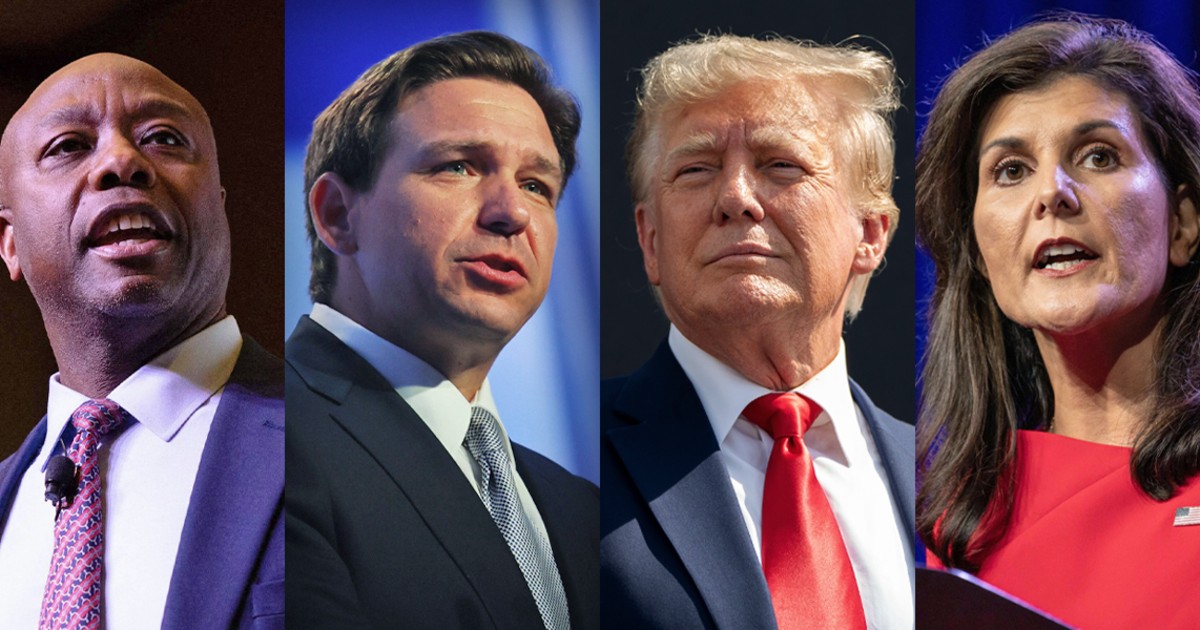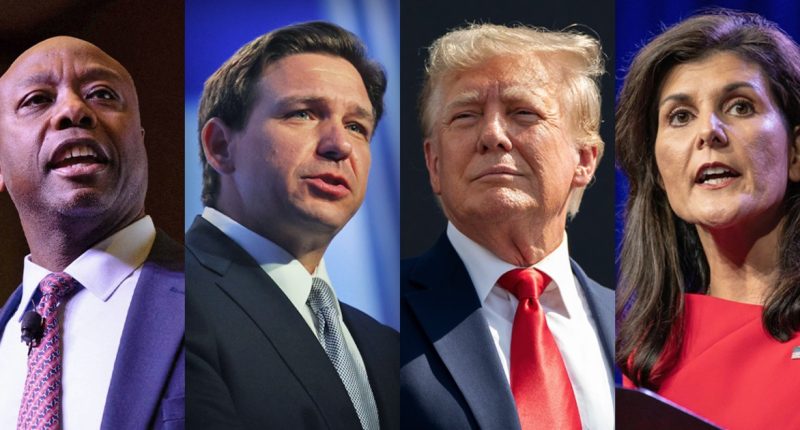
Donald Trump’s rivals for the Republican presidential nomination have a money problem that mirrors their polling problem.
None of them are flush with the kind of cash that would suggest they are poised to take down a frontrunner who has more dollars, universal name recognition and an unmatched capacity to suck up media attention, according to an NBC News analysis of quarterly fundraising reports that were due Sunday to the Federal Election Commission.
Moreover, no one else in the field has built the type of small-donor operation that can be tapped again and again to replenish funds.
Just 4% of Trump’s campaign haul came from donors that have given the maximum primary contribution of $3,300. More than 40% of Florida Gov. Ron DeSantis’ third-quarter sum came from donors who have maxed out to the campaign, according to analysis of his campaign finance report. For Sen. Tim Scott of South Carolina and former South Carolina Gov. Nikki Haley, the share from max-out donors topped 30% of each campaign’s haul.
The numbers mean the non-Trump candidates will rely on the support of aligned super PACs, funded primarily by megadonors, to pay for expensive television ads and other campaign-adjacent activities.
Of that set, the three who finished September in the strongest financial position were Scott, Haley and DeSantis, who had $11.6 million, $9.1 million and $5 million, respectively, in funds available for use in the primary. But Scott collected just $4.6 million in the third quarter after posting $5.9 million in the second quarter, a trend line that moved in the wrong direction.
Overall, the numbers tell the story of a pack of candidates fighting each other for scraps at a time when Trump continues to dominate national and state-by-state polling. He augmented those advantages by kicking his grassroots fundraising machine into overdrive this summer, turning the criminal charges he faces into successful calls for contributions — though a good chunk of that money is being used to cover his astronomical legal fees.
Still, the comparatively lackluster fundraising by other Republicans appears to be a symptom, not the cause, of their inability to gain traction with voters. By raising $24.5 million and spending only $9.5 million from July through September, Trump’s campaign increased his cash on hand by $15 million — more than any other GOP candidate raised during that period.
Most of his rivals have enough money to keep campaigning for weeks or months — whether or not they ever become threats to him — but former Vice President Mike Pence is nearing the end of his runway. His report showed he owed $621,445 in debt of the $1.18 million he had in the bank at the end of last month.
While Trump out-raised his nearest competitor on the Republican side, with his campaign bringing in $24.5 million to the DeSantis campaign’s $11.2 million, President Joe Biden and the Democratic Party posted more than $70 million in combined contributions from the start of July through the end of September.
The numbers aren’t directly comparable, since Biden can pour money into not only his campaign but also the Democratic National Committee and dozens of state parties already preparing for Nov. 2024, and it’s still unclear how much went into Biden’s campaign proper. But the early stockpiling of general-election money on the Democratic side could be crucial in a potential rematch between Biden and Trump. Four years ago, the Democrat’s fundraising edge allowed him to stretch the electoral map on his way to victory in 2020.
Small-dollar struggles
The latest fundraising reports reveal, again, how difficult candidates not named Trump are finding the task of energizing the GOP grassroots.
Each of Trump’s top rivals reported raising the majority of their hauls from donations over $200.
Ramaswamy and DeSantis posted the most money from smaller contributions — $2.8 million and $2.5 million, respectively, from contributions under $200, according to their FEC reports. But both sums were relatively small fractions of the campaigns’ total hauls.
Ramaswamy did appear to see a grassroots fundraising boost around the first GOP debate in August.
Although small-dollar donations are not itemized on the fundraising reports, the campaigns do report how much they spend on credit card processing fees for online fundraising platforms. That provides a rough proxy for the rate at which they’re bringing in online donations.
Ramaswamy’s credit card fee payments doubled in the days following the first Republican debate, when he both delivered and faced the most attacks from his GOP rivals.
His campaign paid $105,000 to WinRed, the major GOP online fundraising platform, on Aug. 27 alone, three days after the first debate. But Ramaswamy’s campaign saw a drop in credit card fee payments in September.
Haley also won praise after the first two debates in August and September. Although she did not see a similar dramatic spike in credit card fee payments, she saw a steady increase throughout the fundraising quarter, signaling a growth in her online fundraising.
In July, her campaign paid WinRed and Anedot, another fundraising platform, $26,000 in fees. That rose to $104,000 in September.
But Haley still raised more money from donors who gave the maximum primary donation, than from donors who gave less than $200, her FEC report shows.
How the 2024 campaigns stack up to the past
Off-year campaign finance reports offer a peek at the health of campaigns, sometimes helping forecast whether they have what it takes to stay in the game.
At this point in the 2016 Republican primary, South Carolina Sen. Lindsey Graham had over $1.6 million in his campaign account at the end of the third quarter and then-Louisiana Gov. Bobby Jindal had just over $260,000 on hand.
Both dropped out within three months.
Pence’s campaign, with its growingdebt and dwindling cash, is in an eerily similar cash position to then-Wisconsin Gov. Scott Walker’s campaign at this point in 2015.
Walker was already accruing debt in the third quarter of that year, leading him to pull the plug on his campaign.
It’s an ominous sign for former Arkansas Gov. Asa Hutchinson and conservative radio host Larry Elder, who ended September with $325,000 and $244,000 on hand, respectively.
Still, campaign cash isn’t a sure predictor of the rest of the race.
In 2019, then-Sen. Kamala Harris ended September with over $10 million on hand for her run for the Democratic presidential nomination. But her campaign was spending it too quickly. Less than three months later, she also suspended her candidacy.
Source: | This article originally belongs to Nbcnews.com









